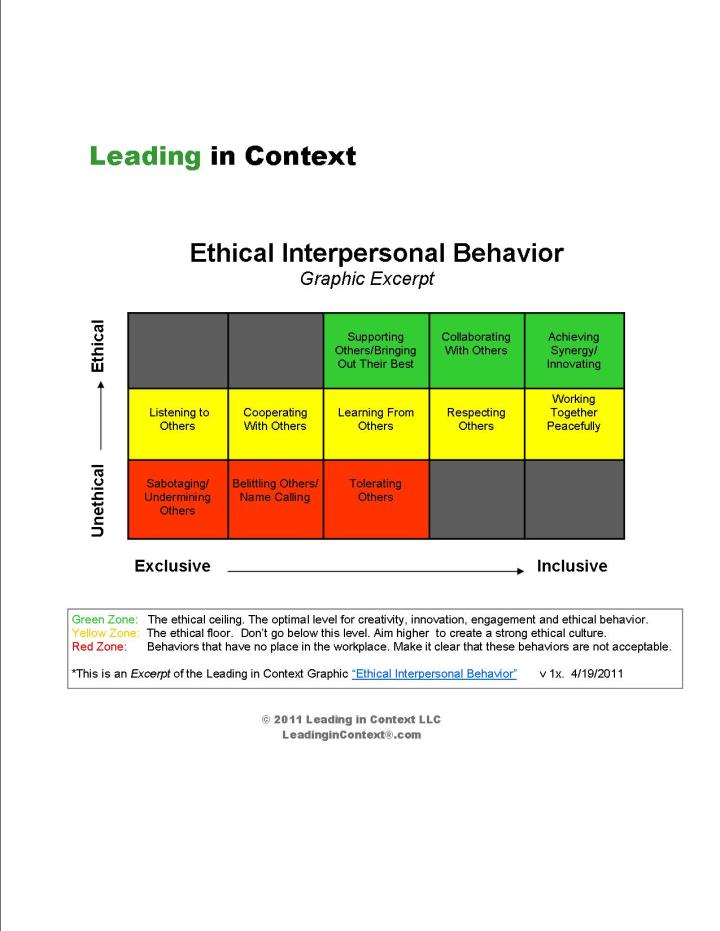How We Treat Each Other Matters
There has been quite a bit of concern expressed recently in the blogosphere about the need for respectful behavior in the workplace and in our day-to-day interactions with one another. Those of you who have expressed concern about harmful behavior, please let me know if this context graphic is useful in providing clear boundaries for interpersonal behavior.
Three Zones of Interpersonal Behavior
The graphic shows three color-coded zones of interpersonal behavior. The green zone says “go – this behavior is ethical,” the yellow zone cautions “this level is the ethical floor – don’t go below it,” the red zone says “stop – this behavior is not appropriate in the workplace.” The full 17-block version of the diagram designed to be used as a training handout is available in the Leading in Context® Store.


For more, see Linda’s book 7 Lenses and the 21 Question Assessment: How Current is My Message About Ethics?
 2014 Axiom Business Book Award Winner
About 7 Lenses
Info@LeadinginContext.com @leadingincontxt @7Lenses
2014 Axiom Business Book Award Winner
About 7 Lenses
Info@LeadinginContext.com @leadingincontxt @7Lenses
© 2011 Leading in Context LLC
Glenda,
Thank you for being willing to share your suggestions. I’ll use your feedback and the feedback of others to make the next revision clearer!
Linda
LikeLike
Thanks, Linda. So “exclusive” here means excluded from consideration? It implies to me exclusion from communication. That was my question. I can easily think of situations where it would be unethical to include everyone in a particular communication or decision-making process. So, for me there are times when exclusion is necessary for ethical action. Perhaps there is another label for this dimension that would be clearer–considering self, considering others or individual, group. I think others have added options that might bypass my confusion. Thanks.
LikeLike
Glenda,
Your comment about the grayed-out quadrants on the graphic is right on point. Since “ethics” fundamentally means acting beyond self-interests (see last week’s post – November 7, 2012), then if we don’t consider anyone besides ourselves, we aren’t being “ethical.” We have to think and behave as though what happens to other people matters in order to be “ethical.” The gray boxes have generated just as much interest as the red, yellow and green boxes, and I had hoped this graphic would stimulate discussions like this. Thank you so much for sharing your observation.
Linda
LikeLike
I may be missing something here, but do you mean to say that it is impossible to be ethical and exclusive at the same time?
LikeLike
John
Wow! You have really provided great observations. So glad you like the visual design. I’m a visual learner too. I look forward to pondering you feedback and using it in the next round of improvements to the graphic. Your 2 cents is very helpful! So glad you took the time to let me know your thoughts.
Linda
LikeLike
Linda,
Nice graphic. Thanks for sharing it. (graphic representations meet my learning style preference for visual-spatial communications).
Having not read your book (!!) I struggled a bit with the use of the terms “ethical” and “unethical” for the vertical axis/rows. I found myself wondering what was implied without being stated overtly. So it’s my problem, not yours. I think this is what I stumbled over:
1) Defining one end of a spectrum as merely the opposite of the other (“un…”) leaves me wondering what IS being articulated as opposed to what is NOT, like saying one end is green and the other end is not green.
2) I am no linguist or ethicist but I think of “ethic” as “the whole package” not the pieces; living out of one’s SET of values. So articulating what those values ARE or which specific value IS being analyzed with the table is the important/challenging bit that’s missing for me. Leaving “it” merely judged as unethical leaves me wondering “according to what ethic?”
I infer from the vertical axis or rows and your context that the layers may articulate the difference between behaviours one could deem “destructive” to “constructive” to “creative” or something like that. But it may be sufficient to label the rows the way you describe them: “unacceptable,” “acceptable,” and “optimal” and let your ethical claim rest in the overall title.
The overall effect is like a “rubric” we can use to assess what is going on. If we were teachers we might move next to providing concrete examples for each of the boxes. That might help people who communicate poorly and would have a different spin on what they are doing.
Anywayz, that’s my 2¢ since you asked.
Thanks again and have a wonderful day!
…john
LikeLike
Jennifer,
Thanks so much for your feedback. I hope that this visual can lead to meaningful conversations about respect and workplace behavior. Glad that you find it useful!
LikeLike
Linda,
What a fantastic visual representation of ethical behaviors for the workplace. I really like the concept of the floors and ceilings; it creates a great mental map of ethical boundaries. Thanks for sharing!
LikeLike